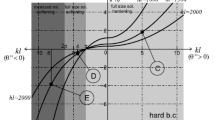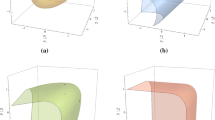Abstract
The evolution of the response of an elastic-plastic bar from the initial unstressed state to rupture is studied with a one-dimensional model based on incremental energy minimization. The model can reproduce both brittle and ductile fracture, as well as an intermediate fracture mode, called ductile–brittle, in which, due to an extreme localization of the plastic deformation, the bar suddenly breaks after a more or less protracted plastic regime. Numerical simulations obtained from the model’s implementation are compared with the results of tensile tests on bars made of steel and of non-reinforced concrete. With an accurate choice of the analytical shapes of the plastic strain energy, not only the overall behavior, but also many details of the experimental response can be captured.
Access this chapter
Tax calculation will be finalised at checkout
Purchases are for personal use only
Similar content being viewed by others
References
Aifantis, E.C.: On the microstructural origin of certain inelastic models. ASME J. Eng. Mater. Technol. 106, 326–330 (1984)
Del Piero, G.: A variational approach to fracture and other inelastic phenomena. J. Elast. 112, 3–77 (2013)
Del Piero, G., Lancioni, G., March, R.: A diffuse energy approach for fracture and plasticity: the one-dimensional case. J. Mech. Mater. Struct. 8, 109–151 (2013)
Hillerborg, A.: Application of the fictitious crack model to different types of materials. Int. J. Fract. 51, 95–102 (1991)
Hordijk, D.A.: Tensile and tensile fatigue behaviour of concrete; experiments, modelling and analyses. Heron 37, 1–79 (1992)
Jirásek, M., Rolshoven, S.: Localization properties of strain-softening gradient plasticity models. Part I: strain-gradient theories. Int. J. Solids Struct. 46, 2225–2238 (2009)
Lancioni, G.: Modeling the response of tensile steel bars by means of incremental energy minimization. J. Elast. 121, 25–54 (2015)
Pham, K., Amor, H., Marigo, J.-J., Maurini, C.: Gradient damage models and their use to approximate brittle fracture. Int. J. Damage Mech. 20, 618–652 (2011)
Author information
Authors and Affiliations
Corresponding author
Editor information
Editors and Affiliations
Rights and permissions
Copyright information
© 2016 Springer International Publishing Switzerland
About this chapter
Cite this chapter
Del Piero, G. (2016). The Variational Approach to Fracture: A Theoretical Model and Some Numerical Results. In: Frediani, A., Mohammadi, B., Pironneau, O., Cipolla, V. (eds) Variational Analysis and Aerospace Engineering. Springer Optimization and Its Applications, vol 116. Springer, Cham. https://doi.org/10.1007/978-3-319-45680-5_7
Download citation
DOI: https://doi.org/10.1007/978-3-319-45680-5_7
Published:
Publisher Name: Springer, Cham
Print ISBN: 978-3-319-45679-9
Online ISBN: 978-3-319-45680-5
eBook Packages: Mathematics and StatisticsMathematics and Statistics (R0)




